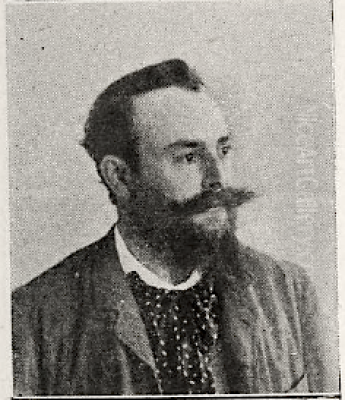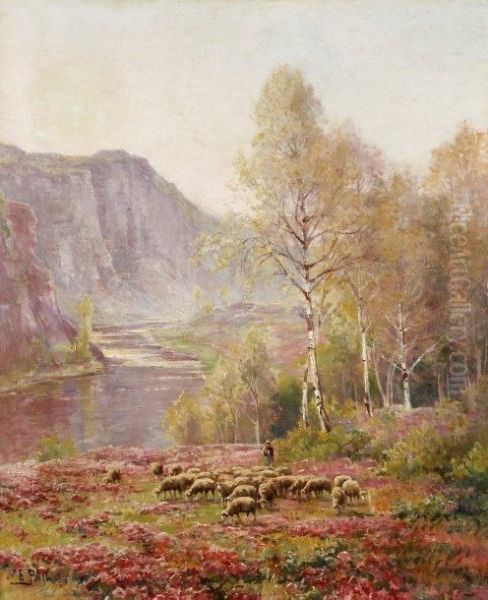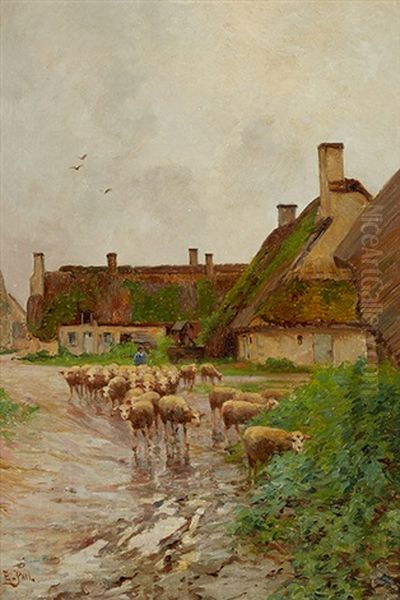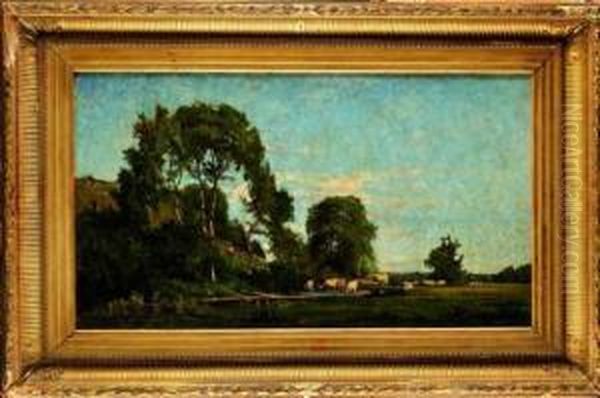
Edouard Pail stands as a notable figure within the landscape of late 19th and early 20th-century French art. Born in 1851 and passing away in 1916, his life spanned a period of immense artistic change, yet his work remained largely dedicated to the enduring themes of rural life and the natural world. As an artist deeply influenced by the preceding generation of Barbizon painters, Pail carved a niche for himself with his sensitive portrayals of pastoral scenes, particularly those featuring sheep and cattle within serene French landscapes. While perhaps not reaching the revolutionary fame of some contemporaries, his contributions offer a valuable window into the continuation of realist traditions and the persistent appeal of agrarian subjects in an era of growing industrialization.
His name is correctly spelled Edouard Pail, and his lifespan is confirmed as 1851 to 1916. He was a French artist active during a vibrant period in his nation's art history. His work consistently reflects a deep connection to the countryside, positioning him firmly within the lineage of French landscape and animal painting. Understanding Pail requires appreciating the artistic currents that shaped him and the specific focus he brought to his canvases.
Early Influences and Artistic Formation
Detailed biographical information about Edouard Pail's early life and specific place of birth remains somewhat scarce in readily accessible records. However, we know he emerged as an artist in the latter half of the 19th century. Crucially, some sources and artwork annotations identify him as an "Elève de Lavoignat," indicating he was a student of Hippolyte Lavoignat (1813-1896). Lavoignat was himself a painter and, perhaps more significantly, a renowned wood-engraver, known for his illustrations, particularly for editions of works like Don Quixote.

Studying under Lavoignat likely provided Pail with a solid grounding in drawing and composition. While Lavoignat's own painting style might have offered some direction, the connection also places Pail within the established artistic training systems of the time. This mentorship, combined with the prevailing artistic atmosphere, would have exposed Pail to the dominant trends and techniques, particularly the burgeoning interest in realism and landscape that had been championed by the Barbizon School. His subsequent career path strongly suggests that the Barbizon ethos resonated deeply with him.
The Enduring Shadow of Barbizon
To fully appreciate Edouard Pail's artistic identity, one must understand the profound influence of the Barbizon School. Flourishing roughly between the 1830s and 1870s, this group of painters congregated around the village of Barbizon, near the Forest of Fontainebleau. They reacted against the idealized landscapes of Neoclassicism and the dramatic narratives of Romanticism, turning instead to the direct observation of nature and the humble realities of rural life. Figures like Jean-Baptiste-Camille Corot, Théodore Rousseau, Jean-François Millet, and Charles-François Daubigny were central to this movement.
The Barbizon painters emphasized realistic depiction, often working outdoors (en plein air) to capture the fleeting effects of light and atmosphere, although finished works were typically completed in the studio. They celebrated the dignity of peasant labor (Millet) and the quiet majesty of the French landscape (Rousseau, Daubigny). Their commitment to truthfulness in representation and their focus on native scenery profoundly impacted subsequent generations, paving the way for Impressionism, even as many artists, like Pail, continued to work within the Barbizon framework.
Pail's work clearly operates within this legacy. His choice of subject matter – shepherds, flocks, cattle, farmsteads, tranquil fields – directly echoes the themes explored by Barbizon masters. His commitment to a realistic, albeit often idyllic, portrayal of these scenes aligns perfectly with the Barbizon spirit. He was, in essence, carrying the torch of this landscape tradition into the later decades of the 19th century.
Artistic Style and Predominant Themes
Edouard Pail's artistic output is characterized by a consistent focus on pastoral and agrarian themes. He excelled in depicting the French countryside, often populating his scenes with the animals that defined rural existence, particularly sheep and cattle. His approach was rooted in realism, seeking to capture the textures of the land, the quality of light, and the naturalistic forms of the animals he painted.

His works are predominantly oil paintings on canvas, a standard medium for the era. Examination of his paintings reveals a careful attention to detail, particularly in the rendering of animal fleece or hides and the varied foliage of trees and fields. He possessed a keen sensitivity to atmosphere, often depicting scenes under the soft light of early morning or late afternoon, enhancing the tranquil and sometimes nostalgic mood of his work. This handling of light, a key concern for the Barbizon painters and later the Impressionists, is evident in Pail's canvases.
Common subjects include shepherds or shepherdesses guiding their flocks through fields or along country lanes, cattle grazing peacefully, and views of farm buildings nestled within the landscape. Titles like Bergère et ses moutons dans les bruyères (Shepherdess and her sheep in the heather) and Berger et son troupeau (Shepherd and his flock) are indicative of his thematic preoccupations. These were not just picturesque scenes; they represented a way of life, a connection to the land that held significant cultural resonance in France.
Master of the Pastoral Scene
Pail's dedication to pastoral subjects places him firmly within a long tradition in Western art, but his specific focus aligns closely with the 19th-century French interpretation. The depiction of shepherds and their flocks, in particular, carries connotations of peace, simplicity, and harmony with nature. In an era marked by increasing urbanization and industrial change, these images often evoked a sense of nostalgia for a perceived simpler, more authentic way of life.
Artists like Jean-François Millet had already elevated the peasant figure to a subject of monumental importance. While Pail's work may not always carry the same socio-political weight as Millet's The Gleaners or The Angelus, it shares a similar respect for rural existence. His paintings celebrate the quiet rhythms of agricultural life and the intimate relationship between humans, animals, and the land. The recurring motif of sheep suggests a particular affinity for these animals, perhaps appreciating their symbolic associations with tranquility and their visual appeal as textured forms within the landscape.
His work La vie à la ferme, près de Corbigny (Farm life, near Corbigny), dated 1872, points to a specific geographical interest. Corbigny, located in the Burgundy region, is known for its agricultural heritage. By grounding his scenes in recognizable French locales, Pail added a layer of authenticity and specificity to his pastoral visions. He wasn't just painting generic countryside; he was chronicling the landscapes and life of rural France.
Expertise in Animal Painting

A significant aspect of Pail's skill lay in his ability as an animalier, a painter specializing in animals. Depicting animals convincingly requires a strong understanding of anatomy, movement, and behavior, combined with the artistic skill to render textures like fur, fleece, and hide. Pail demonstrated considerable proficiency in this area, particularly with sheep and cattle, which feature prominently in his oeuvre.
His animals are not mere accessories in the landscape; they are often the central focus, rendered with care and individuality. He captured the characteristic postures of grazing sheep, the solid forms of resting cattle, and the dynamic movement of a flock on the move, as suggested by the title Le départ des moutons (The departure of the sheep). This focus aligns him with other notable French animal painters.
Constant Troyon (1810-1865), a key member of the Barbizon School, was renowned for his powerful depictions of cattle and other farm animals, often integrated into atmospheric landscapes. Rosa Bonheur (1822-1899) achieved international fame for her meticulous and large-scale animal paintings, such as The Horse Fair. While perhaps working on a less grand scale than Bonheur, Pail shared their dedication to observing and accurately portraying animal life, contributing to this specialized genre within French realism.
Technique and Signature Style
Edouard Pail consistently employed oil on canvas, utilizing techniques that aligned with the realist traditions of the Barbizon School. His brushwork, while capable of capturing detail, often retained a certain painterly quality, avoiding photographic smoothness. This allowed him to convey the textures of nature – the roughness of bark, the softness of fleece, the density of foliage – effectively.
A key element in his work is the handling of light and atmosphere. He seemed particularly drawn to the effects of sunlight filtering through trees, casting long shadows across fields, or illuminating the coats of animals. This sensitivity to light imbues his paintings with mood and a sense of specific time and place. Works like Les Champs (The Fields) likely showcase this ability to capture the expansive feeling and atmospheric conditions of open countryside.
Like many artists of his time, Pail typically signed his works. His signature, "Edouard Pail," is often found in the lower corner of the canvas, frequently the lower right. This practice helps in the attribution and authentication of his paintings as they appear in collections and on the art market. The consistency in his technique and signature aids in identifying his distinct artistic hand.
Representative Works and Market Recognition
Several specific works help illustrate Pail's typical output. Bergère et ses moutons dans les bruyères and Berger et son troupeau highlight his focus on sheep and their human caretakers within natural settings, likely emphasizing the harmony between them. La vie à la ferme, près de Corbigny (1872) provides a dated example and anchors his work geographically, suggesting an early commitment to these themes.
Le départ des moutons implies a more dynamic scene, perhaps capturing the morning movement of a flock to pasture. Les Champs suggests a broader landscape focus, possibly with less emphasis on figures or animals, showcasing his skills in rendering terrain and sky. Auction records provide further insight into his oeuvre and market standing. Works attributed to him appear periodically, often featuring titles centered around shepherds, sheep, cattle, and farm landscapes.
Estimates and sale prices mentioned in various sources, often ranging from €1000 to €3000 for certain pieces, indicate a consistent level of appreciation among collectors of traditional French landscape and animal painting. While not commanding the prices of the leading Barbizon masters or the Impressionists, this demonstrates a solid market presence and recognition of his skill and the appeal of his subject matter. His paintings offer collectors an accessible entry point into the world of 19th-century French pastoral art.
Pail in the Context of Contemporary Art Movements
Edouard Pail worked during a period of radical innovation in French art, most notably the rise and development of Impressionism. While Pail adhered to a more traditional, realistic style derived from Barbizon, he was a contemporary of giants like Claude Monet, Camille Pissarro, Pierre-Auguste Renoir, and Alfred Sisley. These artists, also influenced by Barbizon's emphasis on light and landscape, pushed observational painting in new directions, focusing on capturing fleeting moments, the effects of light and color, and often depicting modern life alongside landscapes.
Pail's work offers a contrast. He remained committed to detailed representation and the established themes of rural life, rather than embracing the broken brushwork, brighter palette, and focus on subjective visual sensation characteristic of Impressionism. However, this does not diminish his significance. It highlights the diversity of artistic practice during the era. Realist traditions, particularly those tied to landscape and rural subjects, continued to thrive alongside more avant-garde movements.
Other contemporaries also continued working in related veins. Léon Lhermitte (1844-1925) gained renown for his large-scale, sympathetic portrayals of peasant life, often with a photographic level of detail. Julien Dupré (1851-1910), Pail's exact contemporary, also specialized in scenes of French farm life, often depicting haymaking and harvest scenes with a vibrant realism. Pail's work fits comfortably within this stream of artists dedicated to chronicling the enduring aspects of the French countryside. There is no readily available information suggesting specific collaborations or intense rivalries between Pail and these figures, but they operated within the same artistic ecosystem, exhibiting at venues like the Paris Salon.
Exhibition History and Recognition
Evidence suggests that Edouard Pail sought recognition through established channels, most notably by exhibiting his work at the prestigious Paris Salon (specifically, the Salon des Artistes Français after the split in the Salon system). Participation in the Salon was crucial for artists in the 19th century to gain visibility, attract patrons, and build their reputation. Successfully having works accepted and displayed was a significant mark of professional achievement.
While records of specific awards or honors bestowed upon Pail at the Salon may not be widely documented, his regular participation underscores his status as a recognized professional artist of his time. The Salon system, despite criticisms and the rise of independent exhibitions (like those of the Impressionists), remained a dominant force in the French art world. Pail's presence there indicates his engagement with this system and the acceptance of his style and subject matter by the juries of the day. The absence of documented major controversies or widely celebrated anecdotes surrounding his career suggests he was likely a steady, respected painter focused on his craft rather than courting public drama.
Legacy and Art Historical Position
Edouard Pail occupies a position in art history as a skilled and dedicated practitioner of the French pastoral tradition, heavily influenced by the Barbizon School. He successfully carried the themes and realistic approach of artists like Troyon and Daubigny into the late 19th and early 20th centuries. His specialization in scenes of sheep, cattle, and shepherds provides a focused body of work that captures the essence of French rural life during his time.
He may not have been an innovator on the scale of the Impressionists or Post-Impressionists like Vincent van Gogh or Paul Gauguin, who were also his contemporaries and also drew inspiration from rural themes (albeit in radically different styles). However, Pail represents the persistence of established traditions and the enduring appeal of realist landscape and animal painting. His work catered to a taste for well-executed, evocative scenes of the countryside, offering a sense of tranquility and connection to nature.
Today, his paintings are appreciated by collectors and enthusiasts of 19th-century French art for their technical competence, atmospheric sensitivity, and charming subject matter. They serve as valuable examples of the Barbizon legacy's continuation and offer insight into the visual culture of rural France before the dramatic changes of the 20th century. Edouard Pail remains a testament to the quiet dedication of artists who find profound meaning and beauty in the enduring landscapes and life of the countryside. His contribution lies in his consistent, sensitive portrayal of a world he clearly observed with affection and skill.